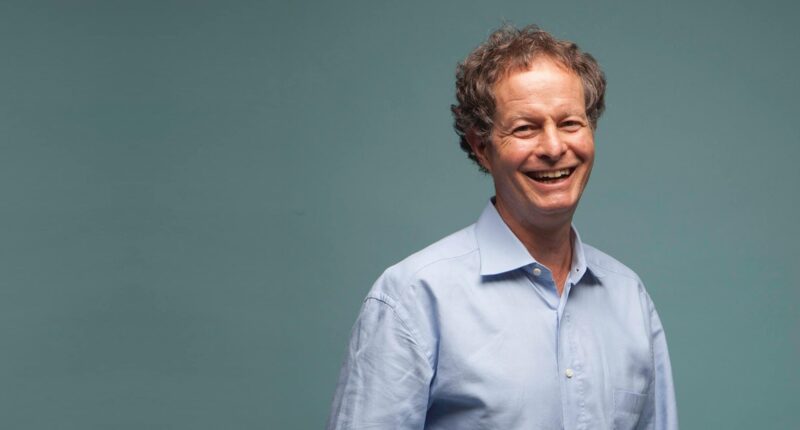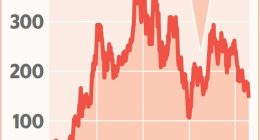John Mackey, the 69-year-old co-founder and former CEO of Whole Foods Market, took his company from a single health food store in Austin, Texas in 1980 to a multinational supermarket chain that sold to Amazon for $13.7 billion five years before his departure in 2022.
Mackey spent more than 40 years building his company, but says, jokingly, that he’s now a “serial entrepreneur” — just one who happened to wait 44 years between his two startups — and his latest venture, health and wellness company Love.Life, is one he’s been thinking up for decades, actually.
With Love.Life, which he co-founded with long-time Whole Foods’ co-CEO Walter Robb and former executive Betsy Foster, Mackey strives to fundamentally shift the way people navigate their health in the U.S.
“Unless something’s wrong, [people] don’t go see a doctor,” Mackey says. “The goal of Love.Life is to change that — to change the way people think about the doctor and the relationship they have with the doctor.”
When people do see a doctor, a “snap diagnosis” and prescription usually follows, Mackey says. Love.Life, in contrast, integrates medical care, nourishing food and wellness therapies “to help you become the healthiest, best version of yourself,” using baseline testing and an individualized plan to achieve that.
Love.Life just announced its virtual health optimization programs, with three membership tiers available across all 50 states and internationally. The company already operates two restaurants, based in Culver City and Miami, and will open its flagship location, a 45,000-square-foot space in El Segundo, California, in 2024.
Entrepreneur sat down with Mackey to learn more about what inspired his latest venture, how his long tenure at Whole Foods informs his approach to business now, and the difference between “serial” and “builder” entrepreneurs.

Image Credit: Courtesy of Love.Life
Related: How Whole Foods CEO John Mackey Is Leading a Revolution in Health and Business
“Our medical system doesn’t really deal with chronic diseases except to manage them through drugs.”
Chronic health conditions like heart disease, cancer and diabetes, largely defined as “conditions that last one year or more and require ongoing medical attention or limit activities of daily living or both,” are the leading causes of death and disability in the U.S., according to the National Center for Chronic Disease Prevention and Health Promotion (NCCDPHP).
Such conditions are also the primary contributors to the U.S.’s $4.1 trillion in annual healthcare costs, per the NCCDPHP. During Mackey’s time at Whole Foods, the company was self-insured; it did have an administrator, but the company paid the claims. Because of the high deductible, “about 10% of team members every year spent 90% of the healthcare dollars,” Mackey recalls.
Mackey notes that some of those costs were unavoidable, citing car accidents or premature births. But a lot of them also went toward managing chronic diseases. “Our medical system doesn’t really deal with chronic diseases except to manage them through drugs, through pharmaceuticals,” he says.
But Mackey saw firsthand how a personalized approach to health and wellness could reverse chronic health conditions. For years, Whole Foods’ Total Health Immersion has given employees the chance to participate in a week-long program that kicks off with a biometric assessment, then provides the tools to improve health: controlled food, education and exercise.
“My big takeaway was that the human body is actually very resilient.”
More than 4,000 Whole Foods team members have gone through the all-expenses-paid program in the past decade, and Mackey was “astounded” by the progress people made in just one week — from losing 10 pounds to reversing type 2 diabetes.
“My big takeaway was that the human body is actually very resilient,” Mackey says. “It wants to be healthy, and if we stop poisoning it and give it the nutrient density that it needs, it begins to recover quickly.”
But the biggest challenge of the program was the lack of ongoing support, Mackey says. When it ended, many people returned to their old environments and habits. Mackey likens the situation to that of an alcoholic who gets sober in rehab but easily falls into unhealthy patterns without guidance in the outside world.
“If they go back into the same social network, what do they like to do? They like to go out to the club or bars,” Mackey says. “And if that’s your social community, you’re going to fall off the wagon. You need people that are supporting you in your journey to sobriety. And it’s not much different with food.”
Love.Life aims to accomplish what a short-term program can’t — to serve as a “one-stop immersive health experience” that supports healing, optimization, longevity and community.

Image Credit: Courtesy of Love.Life
Related: Transparency: How Whole Foods Is Doing It Right (And You Can, Too)
“It’s my baby, and it is now 44 years old, [like] ‘Hey, dad, I don’t want you at home anymore.'”
Although Mackey admits that part of him “didn’t ever want to leave Whole Foods,” he started to consider his timeline in earnest after the Amazon sale. “It was just time,” he says. “In my heart and mind [I made] a five-year commitment. That was the promise I made.”
Mackey had also mentored Whole Foods’ current CEO Jason Buechel for several years and felt that the company didn’t need him in the same way it had for so long. “It’s kind of like, it’s my baby, and it is now 44 years old, [like] ‘Hey, dad, I don’t want you at home anymore,'” he explains.
Mackey gave the company one year’s notice and proceeded to travel to Whole Foods stores nationwide. With 540 at the time, he couldn’t make it to every one, though he was able to visit each region; it was an opportunity to say thank you and goodbye with “lots of tears.” “It was a wonderful departure,” he says.
“I can’t get your products into our stores — I can’t do anything anymore.”
Now, whenever people ask Mackey if he’s sad about no longer working with the company he built from the ground up, he tells them he works hard to stay out of the loop — a strategy that also makes fielding inquiries or requests a lot easier.
“If anybody comes to me complaining about something, it’s like, ‘I’m not in the loop. I can’t help you. I can’t get your products into our stores — I can’t do anything anymore,'” Mackey explains. “And that’s helped me.”
Whole Foods might be in Mackey’s rearview mirror, but, in an interesting twist, his current office is only about 100 yards away from where it was when he worked at Whole Foods. Love.Life headquarters are where Whole Foods Headquarters were from 1995 to 2005; Whole Foods put the space up for rent, and Love.Life leased it. “There’s sentimental value there,” Mackey says.
Related: 3 Entrepreneurial Lessons From the Amazon/Whole Foods Mega Merger
“[My 24-year-old self] probably wouldn’t have listened to me.”
Of course, Mackey is a much different entrepreneur at 69 than he was at 24 when he co-founded his first health food store with his then-girlfriend, who was 20 at the time. Mackey says they “didn’t know anything” about running a business back then.
“We just had a lot of energy and a lot of passion, and we cared about what we did, and we were willing to work really hard,” Mackey says. “We learned from mistakes, and we just improved.”
This time around, Mackey is “bringing a lot more wisdom and knowledge” to his new endeavor, and perhaps slightly less energy, though he has “a lot of energy still.” Mackey’s also armed with a team that’s proven to work well together: In addition to his Whole Foods veteran co-founders, Love.Life boasts Whole Foods’ former CFO Glenda Flanagan and head of real estate Jim Sud.

Image Credit: Courtesy of Love.Life
Although Mackey’s brought “some of the band back together,” he’s also counting on some “bright, talented young people” who have a different perspective. “Every age has its own unique wisdom,” Mackey explains. “So the younger people working for our company bring in a wisdom of youth and possibilities.”
But as for the wisdom Mackey might try to bestow on his 24-year-old self if he could go back? “If I went back and talked to my 24-year-old self and tried to give him some advice,” Mackey says, “he probably wouldn’t have listened to me, so it wouldn’t have made any difference when he said, ‘Get outta here, old man.'”
“I made a lot of mistakes. [But] it turned out really well.”
Mackey’s younger self might not have taken most of his advice, but he probably would have listened where money-costing mistakes were concerned, like what happened when Whole Foods dove into the internet business too soon, Mackey says.
“We started up the internet business back when the dot com bubble was starting,” Mackey explains. “And we were just way early on that — it was a mistake, and we [had to] take a big write-off on that. So I’d go back and say, ‘Wait 10 years to do the internet. They say, if you don’t do it now, you’re going to miss out. That’s wrong. That’s a lie.'”
There were a couple of acquisitions Mackey would advise against too. But turning back the clock isn’t all that necessary, given Mackey’s ultimate success.
“I made a lot of mistakes,” Mackey admits. “[But] it turned out really well. Whole Foods, when I left, [had] $22 billion in sales, 105,000 team members, 540 stores. It was a huge success. So we overcame the mistakes, and the lessons that I learned have made me a better leader. So I’m not sure at the end of the day whether I’d go back and change anything, since it worked out.”
Related: 21 Success Tips for Young and Aspiring Entrepreneurs | Entrepreneur
“The thing I love about a startup like Love.Life is there’s no bureaucracy telling us we can’t do things.”
Today, Mackey’s relying on a different skill set to navigate his second big business act. It divides all entrepreneurs, he says.
“There tend to be two kinds of entrepreneurs,” Mackey explains. “There’s the startup entrepreneur, and then there’s the builder entrepreneur. First, the entrepreneur has to decide — Which one am I?“
Mackey cites one of his friends, who started a dozen businesses and sold them all, as an example of a startup, or serial, entrepreneur. “That’s what he likes to do,” Mackey says. “He likes to start new things, get them up to speed, sell them and then go on to the next thing.”
“In my heart of hearts, I’m an entrepreneur, and I like creating things.”
The builder, on the other hand, stays on at a company. In Whole Foods’ early days, Mackey was in the “startup” mindset; naturally, as the years went on, he assumed a “builder” role.
“In my heart of hearts, I’m an entrepreneur, and I like creating things,” Mackey explains. “I’m a very creative person, and at Whole Foods, I was able to create as we went along, but it got harder as we got bigger. The thing I love about a startup like Love.Life is there’s no bureaucracy telling us we can’t do things.”
Mackey suggests entrepreneurs figure out if they want to be startup serial entrepreneurs or builder entrepreneurs. “If you’re the serial entrepreneur, then my advice is figure out when is a good time to sell so you can go on to your next thing,” he says.
Mackey’s advice for builder entrepreneurs concerns the critical issue of venture capital. He says most venture capitalists and those in private equity will automatically assume you’re a serial entrepreneur, and “they’ll be looking to replace you.”
“If you are going to be a builder, you should be very clear with the investors that you bring in that you’re not looking to sell the business: You’re looking to build it — you hope to grow it for many years, and the exit for them will not be a sale. It’ll be an IPO,” Mackey says.
“[If] the business is not getting them to where they want to get to, they’re going to take over the car.”
As soon as you take venture capital, the clock starts ticking, typically on a seven-year timeline, Mackey says — and he likens venture capitalists to “hitchhikers with credit cards.”
“They get into your car that you’re driving, and as long as you get them to where they want to get to, which is a very lucrative exit, they’ll help pay for the gas and give you some driving advice,” Mackey explains. “But if you get lost, and the business is not getting them to where they want to get to, they’re going to take over the car, and they’re probably going to throw you on the side of the road and hire a new driver.”

Image Credit: Courtesy of Love.Life
Mackey enjoyed his time as a builder at Whole Foods, but he stresses that bureaucracy makes out-of-the-box thinking more difficult, and creative and entrepreneurial people often get weeded out or passed over for promotions because they’re viewed as “disruptors.”
With Love.Life, Mackey has another chance to shake things up — and live up to that “serial entrepreneur” title.
“I’m having a lot of fun [in startup mode] again because we can make decisions quicker,” Mackey says. “We still argue, we still debate, but we can come to decisions quicker, and we can move quicker. So [there’s] kind of a ‘fire, ready, aim’ mentality at Love.Life that Whole Foods used to have, but didn’t have for many years.”
This article is from Entrepreneur.com








